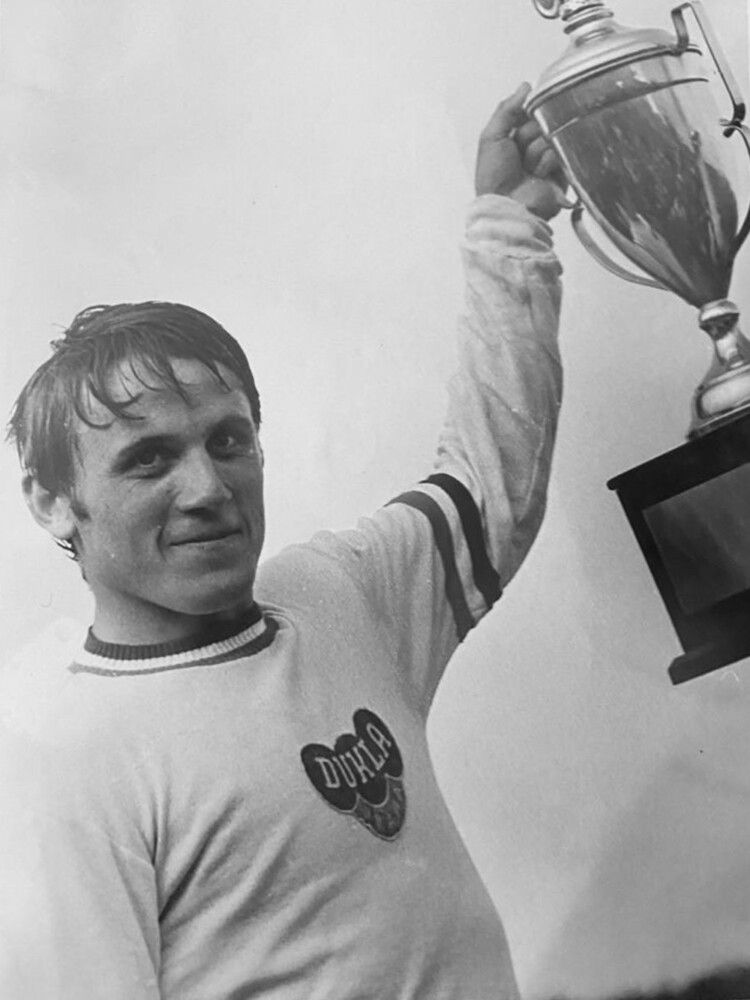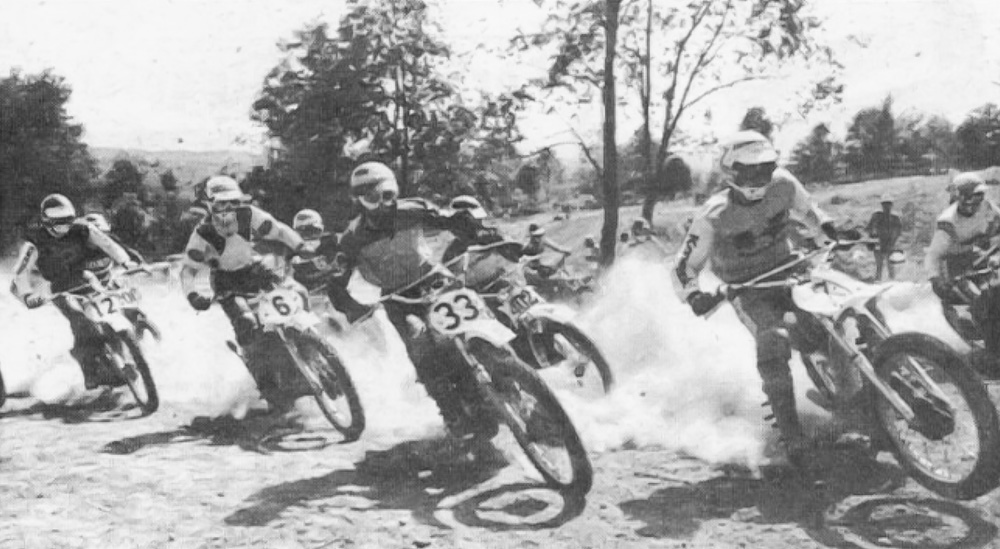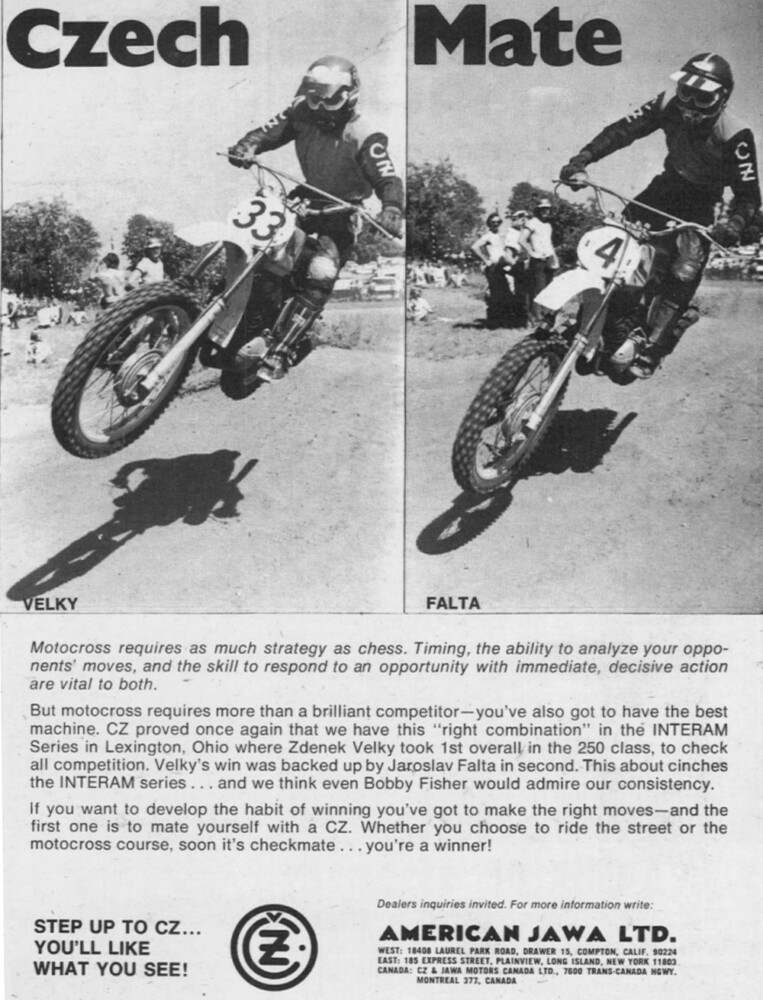| March 12, 2023
Cycle News Archives
COLUMN
Last Of The Glory Years
By Kent Taylor
If today’s race fans could hitch a ride in a Chevy van and go all the way (back to the 1970s), they might find that old-time motocross is not all right with them. Race day, even at the professional level, often seemed to be more like an amateur affair. Program schedules were little more than rough estimates, with the forward falling gates frequently falling hours after the posted time. Promoters fought losing battles against the dust, deploying water trucks that were about as reliable as the race bikes themselves, the latter of which were fouling spark plugs, breaking chains and seizing pistons at almost every race.
 Zdenek Velky was one of the top motocross racers from Czechoslovakia in the 1970s.
Zdenek Velky was one of the top motocross racers from Czechoslovakia in the 1970s.
Such a day was July 13, 1975, in Herman, Nebraska, where an Inter-Am race was held, an event which featured many “finals.” It was the final round of the 1975 series, which also turned out to be the final Inter-Am event ever. When Czech rider Zdenek Velky took the checkered flag in the second moto, it would also be the final moto victory for CZ motorcycles in AMA professional motocross.
Velky’s win marked the end of an era for the Czechoslovakian brand in the U.S. Legendary American riders like Barry Higgins, Sonny DeFeo, Marty Tripes, Brad Lackey and Tony DiStefano had all won races on CZ motorcycles in the early days of AMA professional motocross. Even Bob Hannah got his start in racing aboard a CZ.
But by 1974, many of the famous American CZ riders had either retired or moved on to other brands, so the factory sent Velky and his teammate Jaroslav Falta to represent the marque in both the summer Inter-Am series and the Superbowl of Motocross, held at the Los Angeles Coliseum. And a successful summer it was! Falta, in his first-ever supercross event, was the overall winner at the Superbowl, while Velky secured the championship in the four-race Inter-Am series.
“The 1974 trip was my first visit to the United States,” recalls Velky. “Jaroslav and I were like little kids! Everything was so new to us. Even visiting the 7-11 [convenience store] was an experience, as we couldn’t understand how American gasoline stations worked.”
It was a difficult time to be a Czechoslovakian resident, living under watchful Communist rule and during their time in the U.S., Velky and his CZ teammates were closely monitored by their team managers.
“We didn’t get to travel anywhere other than to the races. Our trip was work, just a summer break and when it ended, we had to return to Europe for the Grand Prix season.”
Although though the once-prestigious series had faded in its importance by the mid ’70s, the Inter-Am series was still contested by all of the major teams. Even Roger DeCoster would make an appearance in the ’74 series. Velky took overall wins in Lexington, Ohio, and again in Springfield, New York, to capture the series’ crown for CZ.
He returned to the U.S. in 1975 but was unable to successfully defend his title. The Nebraska event was Velky’s best ride, though his second-moto victory that day wasn’t enough to overcome a fourth-place finish in the first race, and he finished second to series’ champion Tony DiStefano.
 Velky won the Inter-Am MX Series Championship aboard a CZ in 1974.
Velky won the Inter-Am MX Series Championship aboard a CZ in 1974.
It would be at the Superbowl of Motocross where Velky nearly snagged what would’ve been the signature win of his career. He easily won the first moto (indoor events still used a three-moto format at that time) and finished second in moto two, only to encounter bad luck in the third and final moto.
“I could’ve won it, but I had a few falls in the third moto. The atmosphere was amazing. We were used to big crowds, especially on our home tracks such as the Holice GP, but they were spread out over the countryside, not sitting next to each other in a stadium.”
Like his Czech teammate Falta, Zdenek Velky would not reap the financial fruits of his labor. “We were told that Motokov [the Czech government arm that oversaw international motorcycle and automobile business] had burned down. They said, ‘there is nothing left.’”
Apparently, all Velky’s prize money had been stashed in the building, because he netted nothing for his efforts other than, “a small check I received from Champion Spark Plugs and Castrol Oil endorsements.”
After the Inter-Am Series, Velky returned to Europe and scored two impressive 250 Grands Prix victories, winning both the West German and French GPs. The following season, CZ moved him to the 125 class, where he struggled to be competitive.
“I was not happy with that bike. The engine was very weak…not good performance. I didn’t even want to come to the USA for the 125cc GP that year, but I did, mostly so my teammate Jiri Churavy would not have to be alone. Also, the team told me that I would be responsible for travel expenses, regardless of whether or not I made the trip.”
On that day, Velky went 10-5 for fifth overall, which would be one of the top European performances on a day dominated by American riders Marty Smith, Bob Hannah and Billy Grossi.
Velky’s professional career ended in the 1980s, though he continued to race until 2017, when he was invited to compete in the CZ World Championships in California. “I was surprised to see so many CZ machines in such fabulous condition,” he says. “It is wonderful that people are still riding and racing them.”
No longer under the iron fist, he and his good friend Jaroslav Falta (who passed away last year) were able to visit the places that had been off limits years earlier. “We saw Joshua Tree, Tahoe, Yellowstone and Big Sur,” he says. “I love nature! And driving the coastal highway while dodging California fires was quite an adventure!”
 Velky and fellow countryman Jaroslav Falta went 1-2 at the Inter-Am round in Lexington, Ohio, in 1974.
Velky and fellow countryman Jaroslav Falta went 1-2 at the Inter-Am round in Lexington, Ohio, in 1974.
And what became of CZ? How could a brand that was so successful in the 1960s and early ’70s, capable of winning supercross races in 1975, disappear from the motocross scene just a couple of years later? Velky, now 71, believes that the success of the team riders on the CZs may have ironically helped usher in the company’s demise.
“The works bikes had many modifications to be competitive,” he says. “We had different ignition, carburetor, forks and shocks. But the factory only saw that we were winning races and they decided that the everyday bikes were fine. They saw nothing wrong with your average CZ.”
While that “average CZ” may have been a good motorcycle in 1975, motocross was evolving, and last year’s bikes were like yesterday’s fish. By 1977, CZs had vanished from AMA results. As late as 1992, the company was still offering a 400cc model that was sprung with twin shocks, powered by an air-cooled motor and looking very much like it was 1975 all over again.
“They were stuck” Velky says today, “in the lost, glory years.”
CN thanks Martina Faltova-Cope for her assistance in translation. For more information on, “The Stolen Title,” the story of her father Jaroslav Falta’s 1974 Grand Prix season, visit faltabook.com. CN